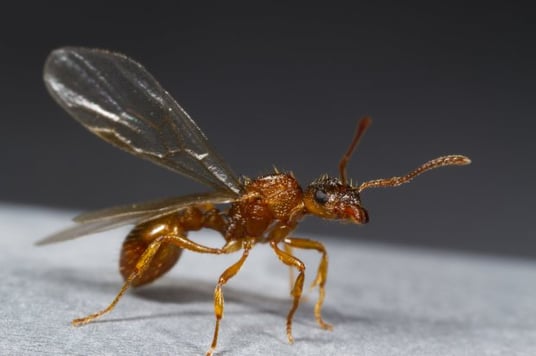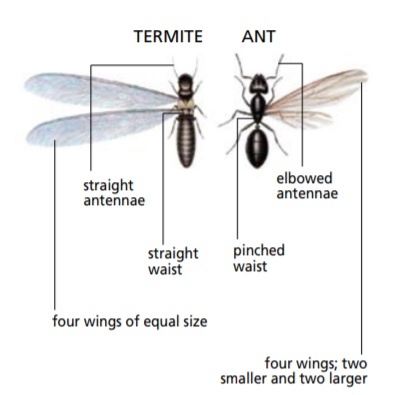Learn About Flying Ant Behavior and Biology in NJ and PA
 Most of the ants you will encounter in New Jersey and Pennsylvania are wingless. However, you may encounter a swarm of flying ants at different times of the year. Flying ants have pinched waists with bent antennae and are often mistaken for swarming termites. They have two sets of wings, one larger than the other. Depending on their species, flying ants may swarm at different times of the year. Flying ants may also be mistaken for termites, which can lead to larger issues. Flying ants cause panic among homeowners because of their tenancy to burst in very large numbers with no warning. Their swarming behavior is alarming for homeowners, especially when they experience it for the first time. The top things to be concerned about when you are dealing with flying ants are:
Most of the ants you will encounter in New Jersey and Pennsylvania are wingless. However, you may encounter a swarm of flying ants at different times of the year. Flying ants have pinched waists with bent antennae and are often mistaken for swarming termites. They have two sets of wings, one larger than the other. Depending on their species, flying ants may swarm at different times of the year. Flying ants may also be mistaken for termites, which can lead to larger issues. Flying ants cause panic among homeowners because of their tenancy to burst in very large numbers with no warning. Their swarming behavior is alarming for homeowners, especially when they experience it for the first time. The top things to be concerned about when you are dealing with flying ants are:
1. Identification: Flying ants can be easily mistaken for termite swarmers. Termites are typically a much larger issue and need to be dealt with differently from both a homeowner and pest control professional point of view.
2. The Source: Where are they coming from? Carpenter ants behave differently than tiny pavement or other nuisance ants. Finding the nest and addressing the root of the problem will provide relief.
Why do I have flying ants?

Photo Credit: metro.co.uk
In order to expand the number of colonies in a given area, they need to reproduce. Flying ants aren't their own species, but instead a type of ant within a colony with a specific task. To begin the breeding process, flying ants swarm in giant numbers all at once. They mate and the male dies. The goal is for the female to make it back outdoors after mating and to start a new colony. Flying ants aren't especially interested in humans, so they are more of an eyesore than anything else.
indoors vs. outdoors
Are flying ants dangerous?
Flying ants themselves are not dangerous. Their only goal is to mate, so they are not focused on trying to interact with humans. In fact, it benefits the flying ants to stay away from people as a means for survival. If you are seeing a swarm of tiny nuisance ants (ants you find trailing in your kitchen or bathroom) there is no imminent threat. They are not poisonous, do not bite, and do not cause any structural damage. However, if you are seeing a carpenter ant swarm, it's likely that carpenter ants are somewhere in or around your property. Carpenter ants are wood-destroying insects and can inflict damage on your home. Most homeowners do not like flying ants because of the unsightly and unexpected, sometimes intense swarms they cause. If you are nervous about flying ants in your home, simply vacuum them up as you see them. Keep in mind, if you vacuum ants up, you aren't killing off other ant colonies that are already active around your property.
What is the difference between flying ants and termites?
There are four key differences between flying ants and termites. Flying ants have a pinched waist and elbowed antennae, which often has them being mistaken for termites.

They also have two sets of wings, one set is larger than the second. Termites, however, have straight antennae and their wing sets are of equal length. They also have more of a tubular, thick waist. Another major difference is that termites lose their wings readily, shedding them onto the ground, whereas the wings on ants typically remain attached to the insect’s body. Winged termites tend to swarm in the early spring when it is warm and rainy. Flying ants, depending on the species, can swarm at different times throughout the year. If you happen to notice clusters of discarded wings, it’s possible you have termites. Both swarm in similar ways, but the rest of their behavior is completely different. To learn more about the differences between flying ants and termites, read our blog post by clicking here.
How can I get rid of flying ants?
Controlling the flying ant population at your home can be challenging to do on your own. Once a swarm begins, flying ants will emerge in as many as hundreds of thousands. Fortunately, this typically only lasts for a few hours to a few days and then ceases. The goal of flying ants is to use their wings to leave the colony and reproduce. You can vacuum up flying ants and dispose of them as they are visible. The best way to take care of flying ant infestations is to call a professional pest control company so they can address the ant nest on your property.
How can Cooper help?
The most important thing to know about flying ant activity is that it will not last forever. Swarms burst for a short amount of time and then cease entirely. Unfortunately, there is nothing you can do to reduce the amount of flying ants or stop them from emerging once they begin appearing. Flying ants are originating from a colony on your property. If you have flying ant activity, our technician will analyze the ants to determine if they are pavement ants, honey ants, odorous house ants, or any other small nuisance ant. Once they identify the kind of ant that is swarming, they can then search for the nest and treat accordingly. Both our Home Intensive Plan and Home Traditional Plan provide year-round coverage with both proactive and reactive service for flying ant activity.
The Intensive Service Plan is designed to provide preventive pest and rodent control for your home, year round. This plan includes both preventative and reactive services for flying ant activity. This is our most popular service for homeowners. The service plan includes four preventive services per year. Each service is unique and will be accompanied by a detailed 30-point inspection report with detailed findings as well as providing you with important recommendations for your home. Each year you will receive three exterior maintenance services (March – November) and one interior service (December – February). The winter service will focus on the interior of the structure and is geared towards rodents and other pests that may live within the structure.
The Traditional Service Plan is a substantial value for the homeowner that does not want to be bothered by crawling insects, mice, and wasps. This plan includes both preventative and reactive services for flying ant activity. The Traditional Service Plan provides preventive pest and rodent control for your home, year round. As part of your plan, you will receive four services per year. Each year you will receive three exterior maintenance services (March – November) and one interior service (December – February). There are some exclusions in the Traditional Service Plan when compared to the Intensive Service Plan.
Add optional year-round termite control and monitoring services to your Intensive or Traditional Service Plan for full coverage! Our constantly active bait stations eliminate termites before they reach your home.
To learn more about our pest control plans, please give us a call at 1-800-949-2667 or fill out the contact form on this page. Learn more about identifying termites and flying ants by reading our blog post here.












